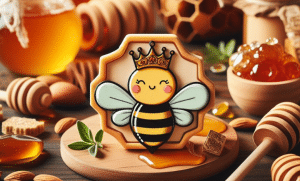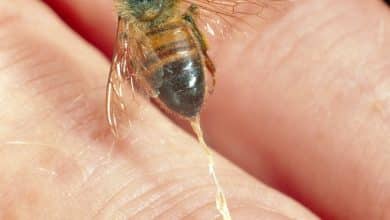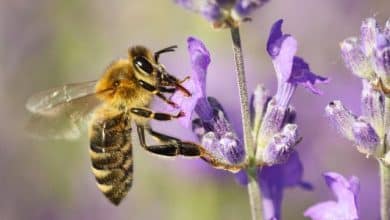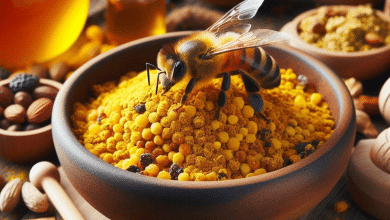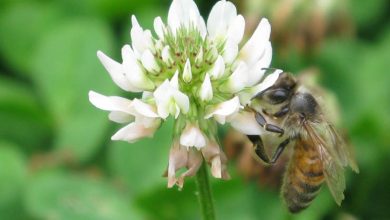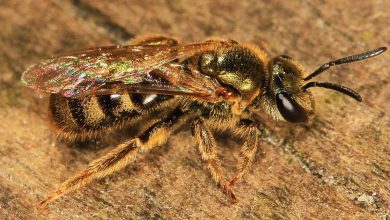Queen Bee Honey The Journey from Hive to Jar

Queen Bee Honey play a crucial role in the hive, serving as the mother to all the bees within. Their life begins when they are born from a specially selected cell. They have a larger body size compared to worker bees, with a distinct elongated abdomen.
Once hatched, the queen bee takes on the responsibility of laying eggs. She can lay up to 2,000 eggs per day, ensuring the continuous growth and replenishment of the hive population. The queen bee is attended to by worker bees, who feed and groom her to maintain her health and vitality.
While the worker bees carry out various tasks to support the hive, the queen’s main focus is reproduction. She releases pheromones that help regulate the behavior and development of her colony. This chemical communication ensures harmony and synchrony among the bees.
The lifespan of a queen bee varies, depending on factors such as mating success and environmental conditions. On average, a queen bee can live up to five years. However, in some cases, they may need to be replaced if their reproductive capabilities decline. When a new queen bee is born, the old queen usually leaves the hive with a swarm of bees to establish a new colony elsewhere.
Overall, the life of a queen bee in the hive is centered around her role as the mother and leader of the colony. Her vital role in honey production and hive sustainability is essential for the survival and growth of the bee population.
The Role of the Queen Bee in Honey Production
The queen bee plays a crucial role in honey production within the hive. She is responsible for laying the eggs that will develop into worker bees, who will then gather nectar from flowers to produce honey. The queen bee’s primary purpose is to ensure the continuous growth and replenishment of the hive population.
Through her pheromones, the queen bee helps regulate the behavior and development of her colony. These chemical scents help maintain harmony and synchrony among the bees, ensuring efficient honey production.
As the only female with fully developed ovaries, the queen bee can lay up to 2,000 eggs per day. This high egg-laying capacity is essential for maintaining a strong workforce of worker bees who will collect nectar for honey production.
The health and vitality of the queen bee are crucial for honey production. She is attended to by worker bees who feed and groom her, ensuring she remains in optimal condition to carry out her reproductive duties.
In summary, the queen bee’s role in honey production is vital. Through her egg-laying abilities and chemical communication, she ensures the growth and harmony of the hive, ultimately leading to the production of delicious honey.
Queen Bee Lifecycle and Behavior
The lifecycle of a queen bee begins with the hatching of an egg. The queen bee larva is fed a special substance called royal jelly, which triggers her development into a queen. This nutritious diet sets her apart from other bees in the hive.
As the queen bee grows, she undergoes several molting stages, shedding her old skin and growing a larger one. This process allows her to reach her full size and maturity. Once fully developed, she emerges from her cell as a queen bee.
The behavior of a queen bee is unique compared to other bees in the hive. She is the largest bee, with a long and slender abdomen. The queen bee’s primary role is reproduction. She mates with multiple drones from other colonies during a single mating flight.
After mating, the queen bee returns to the hive and begins laying eggs. She can lay up to 2,000 eggs per day, ensuring the continuous growth and replenishment of the hive population. The queen bee also emits pheromones that regulate the behavior and development of the worker bees.
The queen bee is highly revered and cared for by the worker bees. They feed and groom her to maintain her health and vitality. The longevity of a queen bee varies, but she can live for several years if well-taken care of by the colony.
In summary, the lifecycle and behavior of a queen bee are essential for the survival and productivity of the hive. Her unique qualities and reproductive abilities contribute to the overall success of honey production and maintaining a thriving bee population.
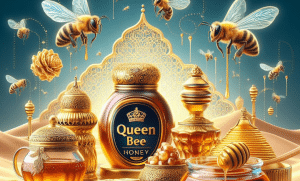
Production Process of Queen Bee Honey
The production process of Queen Bee Honey involves several steps to ensure the highest quality and delicious taste.
First, the beekeepers harvest the honeycombs from the hive. These honeycombs are carefully selected, as they contain the ripest honey.
Next, the beekeepers extract the honey from the honeycombs. They use specialized equipment, such as centrifugal extractors, to gently remove the honey without damaging the combs.
Once the honey is extracted, it goes through a process of quality control. The beekeepers check the moisture content and purity of the honey to ensure it meets the highest standards.
After quality control, the honey goes through a filtration process. This removes any impurities, such as wax and bee parts, to ensure a smooth and clear product.
The final step in the production process is packaging and labeling. The honey is carefully packaged in jars or bottles, ready for sale. The labels provide important information about the honey, such as its origin and nutritional content.
Overall, the production process of Queen Bee Honey is a meticulous journey that involves careful harvesting, extraction, quality control, filtration, and packaging. This ensures that every jar of Queen Bee Honey is of the highest quality and ready to be enjoyed by honey lovers around the world.
Harvesting Honeycombs to Extract Honey
Harvesting honeycombs and extracting honey is a crucial part of the production process of Queen Bee Honey. Beekeepers carefully remove the honeycombs from the hive, ensuring they select the ones containing the ripest honey. The honeycombs are brought to the processing area where the honey extraction takes place.
Beekeepers use specialized equipment, such as centrifugal extractors, to gently remove the honey from the honeycombs. The honeycombs are uncapped, and the honey is spun out from the comb through centrifugal force. This method allows the honey to be extracted without damaging the combs, allowing for reuse.
The extracted honey is collected in containers and transferred to a settling tank. This allows any air bubbles and impurities to rise to the top, ensuring a smoother and clearer product. After the settling process, the honey is carefully strained to remove any remaining wax or bee parts.
The harvested honey is then ready for further processing, such as filtering and packaging. It is important to handle the honey with care during the harvesting process to preserve its quality and flavor. Beekeepers take pride in harvesting honeycombs and extracting honey as it is the result of their hard work and the remarkable efforts of the honey bees.
Quality Control and Honey Filtering
Quality control and honey filtering are essential steps in the production process of Queen Bee Honey. Beekeepers understand the importance of ensuring that their honey meets the highest standards of quality before it reaches consumers.
To maintain the purity and consistency of the honey, beekeepers employ various methods of filtration. This process involves removing any impurities, such as wax particles, bee parts, and air bubbles.
Commercial honey filtration often involves the use of sophisticated machinery and techniques. However, even backyard beekeepers can achieve excellent results through a simple method called honey straining. This method involves pouring the honey through a fine-mesh strainer or cheesecloth to remove any solid particles.
By carefully filtering the honey, beekeepers can ensure that it is smooth, clear, and free from any unwanted debris. This not only enhances the visual appearance of the honey but also improves its taste and texture.
The filtration process is an integral part of quality control measures that beekeepers follow to deliver a superior product to their customers. By adhering to these standards, the honey produced by Queen Bee Honey consistently meets the highest quality requirements.
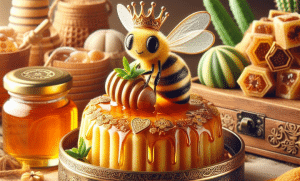
Packaging and Labeling of Queen Bee Honey
Packaging and labeling play crucial roles in ensuring that Queen Bee Honey reaches consumers in a safe and appealing manner.
When it comes to packaging, the honey is typically stored in glass jars or plastic containers. Glass jars are a popular option as they are durable, non-reactive, and provide excellent protection against light and air. Plastic containers, on the other hand, offer the advantage of being lightweight and shatterproof.
To maintain the integrity of the honey, the containers are sealed tightly to prevent any leakage or contamination. This ensures that the honey remains fresh and of high quality. Additionally, the packaging materials used are chosen carefully to be environmentally friendly and sustainable.
Proper labeling is equally important as it provides essential information to consumers. The label includes details such as the name of the honey, the net weight, the origin of the honey, and any certifications or quality standards it adheres to. It may also include nutritional information and storage recommendations.
Clear and accurate labeling helps consumers make informed choices about the honey they purchase. It builds trust and transparency between the producer and the consumer.
Packaging and labeling practices adopted by Queen Bee Honey reflect their commitment to delivering a superior product while prioritizing consumer satisfaction and environmental responsibility.
Sustainable Packaging Practices
Sustainable packaging practices are crucial in the honey industry to reduce environmental impact and promote long-term sustainability. Producers of Queen Bee Honey have embraced eco-friendly packaging options to minimize the use of single-use plastics and prioritize the use of recyclable materials.
The packaging materials chosen for Queen Bee Honey include glass jars and recyclable plastic containers. Glass jars are a popular choice as they are durable and non-reactive, preserving the quality of the honey while being recyclable. Recyclable plastic containers provide the advantage of being lightweight and shatterproof, reducing the risk of breakage during transportation.
In addition to the choice of materials, suppliers of Queen Bee Honey focus on local sales channels, such as farmers markets and local food stores. This reduces the carbon footprint associated with long-distance transportation and ensures the honey reaches consumers quickly, maintaining its freshness.
Furthermore, sustainable packaging extends beyond the materials used. Some producers have implemented initiatives such as utilizing biodegradable containers, using reusable beeswax wraps, and introducing bulk honey dispensers in zero-waste shops.
By adopting sustainable packaging practices, Queen Bee Honey aims to minimize waste, conserve resources, and contribute to the overall health and well-being of the environment. These efforts reflect their commitment to responsible and eco-friendly honey production.
Importance of Proper Labeling for Consumer Information
Proper labeling is of utmost importance for consumer information when it comes to Queen Bee Honey. Clear and accurate labeling provides crucial details about the honey, ensuring transparency and helping consumers make informed choices.
Including information on the origin and floral source of the honey allows consumers to understand the unique characteristics and flavor profiles of each batch. This transparency helps build trust and fosters a connection between consumers and the honey they choose to purchase.
Furthermore, proper labeling helps address any potential allergens or dietary restrictions. It allows individuals with specific dietary needs to easily identify if the honey contains any ingredients that they should avoid.
Labeling also plays a key role in ensuring food safety. It provides essential information such as expiration dates, storage instructions, and any special handling recommendations. This empowers consumers to store and consume the honey in a way that maintains its quality and prevents any potential health risks.
By providing clear and accurate labeling, Queen Bee Honey prioritizes consumer safety and satisfaction. It allows individuals to make well-informed choices while enjoying the pure and delicious honey produced by the hardworking bees.
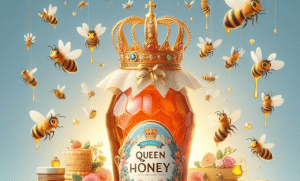
Health Benefits of Queen Bee Honey
Queen Bee Honey offers a range of health benefits that make it a truly remarkable natural sweetener.
- Nutritional Value: Queen Bee Honey is rich in vitamins, minerals, and antioxidants, making it a nutritious addition to your diet. It contains essential nutrients such as vitamin C, calcium, iron, and phosphorus.
- Immune System Boost: The antioxidants found in Queen Bee Honey can help strengthen the immune system, protecting the body from harmful free radicals and reducing the risk of diseases.
- Wound Healing: The anti-inflammatory properties of Queen Bee Honey can speed up the healing process of wounds and burns. Its natural antibacterial properties also help fight infection.
- Soothes Sore Throats: When mixed with warm water or herbal tea, Queen Bee Honey can provide relief for a sore throat, soothing irritation and reducing coughing.
- Energy Boost: The natural sugars in Queen Bee Honey can provide an instant energy boost, making it an excellent choice for athletes or those in need of a natural pick-me-up.
- Digestive Health: Queen Bee Honey has prebiotic properties that promote the growth of beneficial gut bacteria, aiding in digestion and improving overall gut health.
Incorporating Queen Bee Honey into your diet can enhance your overall well-being and support a healthy lifestyle. Enjoy the delicious taste while reaping its numerous health benefits.
Nutritional Value of Raw Honey
Raw honey is not just a delicious sweetener, but it also offers a range of nutritional benefits. Packed with vitamins, minerals, and antioxidants, raw honey is a natural source of nourishment.
One of the key nutritional components of raw honey is its vitamin content. It contains essential vitamins such as vitamin C, which is known for its immune-boosting properties. Additionally, raw honey is a source of minerals like calcium, iron, and phosphorus, which are vital for maintaining strong bones and overall health.
Raw honey is also rich in antioxidants, which play a crucial role in neutralizing harmful free radicals in the body. These antioxidants help protect the body’s cells from damage and reduce the risk of chronic diseases, including heart disease and certain types of cancer.
Furthermore, raw honey has natural enzymes that aid in digestion and promote better gut health. It can help soothe stomach discomfort and improve overall digestive function.
Although raw honey is a natural sweetener, it is important to consume it in moderation due to its high calorie and sugar content. However, its nutritional value makes it a healthier alternative to processed sugars.
Including raw honey in your diet can provide you with a natural source of vitamins, minerals, and antioxidants, supporting your overall health and well-being.
Medicinal Uses and Healing Properties
Queen Bee Honey is not only a delicious natural sweetener, but it also possesses remarkable medicinal uses and healing properties. This golden elixir has been used for centuries in traditional medicine for its various therapeutic benefits.
Firstly, Queen Bee Honey is known for its antibacterial and antimicrobial properties, making it effective in fighting against infections. It can be applied topically to wounds or burns to promote healing and prevent bacterial growth.
Furthermore, Queen Bee Honey has anti-inflammatory properties, which can help alleviate symptoms of conditions such as sore throats and coughs. It can be consumed directly or added to warm teas to soothe irritated throats and reduce coughing.
Additionally, Queen Bee Honey has been found to have antioxidant properties, which can help protect the body against damage caused by free radicals. This can contribute to overall health and may reduce the risk of chronic diseases such as heart disease and cancer.
Moreover, Queen Bee Honey is also known for its soothing and moisturizing effects on the skin. It can be used as a natural remedy for dry or irritated skin, providing hydration and promoting a healthy complexion.
Overall, Queen Bee Honey offers a range of medicinal uses and healing properties, making it a versatile and beneficial natural remedy. Incorporating this golden elixir into your daily routine can support overall health and well-being.
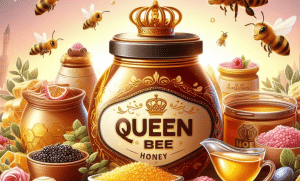
Supporting Bee Conservation Efforts
Supporting bee conservation efforts is crucial for preserving the delicate balance of our ecosystem. Bees play a vital role in pollination, which is essential for the reproduction of many plants. Unfortunately, bees face numerous threats such as habitat loss, pesticide use, and climate change.
There are several ways individuals can contribute to bee conservation. Planting bee-friendly flowers and creating bee-friendly habitats in gardens and green spaces can provide bees with a diverse and abundant source of nectar and pollen. Avoiding the use of harmful pesticides and opting for organic gardening practices can also protect bees and other pollinators.
In addition to individual efforts, supporting organizations and initiatives focused on bee conservation can make a significant impact. Donating to bee conservation organizations, participating in citizen science projects, and advocating for policies that protect bees and their habitats are all meaningful ways to contribute.
Education also plays a vital role in bee conservation. Spreading awareness about the importance of bees and their role in our ecosystem can inspire others to take action and make a difference. Teaching children about bees and their significance can foster empathy and environmental stewardship from a young age.
By collectively working together to support bee conservation efforts, we can help ensure the survival and well-being of these remarkable pollinators and the health of our natural world.
The Importance of Bee Population Sustainability
Bees play a vital role in the pollination of plants, making them essential for the sustainability of ecosystems. The importance of bee population sustainability cannot be overstated.
Without bees, the reproduction of many plants, including fruits, vegetables, and flowering plants, would be severely impacted. Bees transfer pollen from the male part of a flower to the female part, allowing plants to produce seeds and fruits. This process is crucial for maintaining biodiversity and ensuring the availability of food for humans and wildlife alike.
Furthermore, bees contribute to the overall health of the environment. They help maintain the balance of plant communities and support the growth of natural habitats. Their pollination efforts also contribute to the production of seeds, which are essential for regenerating plant populations.
However, bee populations worldwide are facing numerous threats, including habitat loss, pesticide use, and climate change. These factors have resulted in a decline in bee populations, which has serious implications for food security and the health of ecosystems.
It is crucial to prioritize bee population sustainability through conservation efforts. This includes preserving and creating bee-friendly habitats, reducing the use of harmful pesticides, and raising awareness about the importance of bees and their role in our ecosystem.
By taking action to protect bees and their habitats, we can ensure the continued pollination of plants, the maintenance of biodiversity, and the overall health of our environment.
How Consumers Can Help Protect Bees
Consumers play a crucial role in protecting bees and their habitats. Here are some ways consumers can contribute to bee conservation efforts:
- Choose Organic and Bee-Friendly Products: Opt for organic produce, as they are grown without the use of harmful pesticides that can harm bees. Look for products that are labeled as bee-friendly, indicating that they support bee conservation.
- Plant Bee-Friendly Gardens: Create a bee-friendly garden by planting flowers, herbs, and native plants that attract bees. Provide them with a variety of nectar and pollen-rich plants to feed on and create a diverse habitat for them.
- Avoid Using Pesticides and Chemicals: Reduce or eliminate the use of pesticides and chemicals in your garden and yard. These substances can be toxic to bees and other pollinators.
- Support Local Beekeepers: Purchase honey and other bee-related products from local beekeepers who practice sustainable beekeeping methods. This supports their efforts in maintaining healthy bee populations.
- Educate Others: Spread awareness about the importance of bees and the challenges they face. Encourage others to take action by sharing information about bee conservation and the need to protect their habitats.
By making simple changes in their daily lives, consumers can contribute to the protection of bees and ensure their survival for future generations. Every individual effort counts towards creating a healthier environment for these vital pollinators.
Queen Bee Honey takes great pride in the journey of their natural honey products, from hive to jar. Every step of the process is carefully executed to ensure the purest and most flavorful honey reaches consumers’ homes.
By highlighting the uniqueness of natural honey, Queen Bee Honey sets itself apart from other honey suppliers. Their commitment to purity and quality shines through in each jar of honey they produce.
The diverse range of natural honey products offered by Queen Bee Honey showcases their dedication to providing customers with a variety of options. From the traditional raw honey to infused flavors, there is something for everyone to enjoy.
Queen Bee Honey story, starting with Mercedes’ passion for bees and honey, adds a personal touch to their brand. The family tradition and deep-rooted commitment to nature further emphasize their authenticity and values.
In conclusion, Queen Bee Honey journey from hive to jar is a testament to their dedication to producing pure and delicious honey. With a wide range of natural honey products and a commitment to sustainable practices, Queen Bee Honey is a brand that can be trusted for its quality and taste.
The Journey of Queen Bee Honey from Hive to Jar
Once the honey is harvested from the bee hives, it undergoes a careful production process before it is ready to be enjoyed in jars. The journey of Queen Bee Honey from hive to jar ensures that the purest and most flavorful honey reaches consumers’ homes.
The first step in this process involves harvesting the honeycombs. Beekeepers carefully collect the honeycombs from the hives, making sure to handle them with care to preserve their natural qualities. Then, the honeycombs are taken to a facility for extraction.
During the extraction process, the honeycombs are spun in a honey extractor to separate the honey from the wax. This raw honey is then carefully filtered to remove any impurities and ensure its purity. Queen Bee Honey takes great pride in their quality control measures to ensure that only the finest honey is produced.
Once the honey has been filtered, it is ready for packaging. Queen Bee Honey uses sustainable packaging practices, prioritizing recyclable and eco-friendly materials. This reflects their commitment to environmental responsibility.
Finally, the jars of Queen Bee Honey are labeled with detailed information about the honey, including its origin and nutritional content. Proper labeling provides consumers with essential information and enhances their overall experience.
From hive to jar, Queen Bee Honey goes through a meticulous journey to deliver the highest quality and most delicious honey. Every step of the process is thoughtfully executed to ensure that customers can enjoy the pure and natural goodness of this golden liquid.
Recipe Ideas and Recommendations for Using Queen Bee Honey
When it comes to using Queen Bee Honey, the possibilities are endless. Here are some recipe ideas and recommendations for incorporating this delicious honey into your culinary creations.
- Sweetening Beverages: Add a drizzle of Queen Bee Honey to your tea, coffee, or smoothies for a natural sweetener that adds depth and complexity to your drinks.
- Baking Delights: Replace sugar with Queen Bee Honey in your favorite recipes for baked goods. It adds a subtle floral note and moist texture to cakes, cookies, and bread.
- Salad Dressings: Create a homemade salad dressing by combining Queen Bee Honey with vinegar, olive oil, and herbs. It adds a touch of sweetness to balance out the tanginess of the dressing.
- Glazes and Marinades: Use Queen Bee Honey as a glaze for roasted meats and vegetables. Its natural richness caramelizes beautifully and enhances the flavors of your dishes.
- Cheese Pairings: Enjoy Queen Bee Honey drizzled over a variety of cheeses, combining sweet and savory flavors. It pairs exceptionally well with tangy goat cheese or creamy brie.
- Honey-Lavender Ice Cream: Whip up a batch of homemade ice cream infused with Queen Bee Honey and dried lavender. It creates a delightful floral and sweet treat.
Remember to store Queen Bee Honey in a cool, dry place, away from direct sunlight, to maintain its quality and flavor. Experiment with these recipe ideas, and let the natural goodness of Queen Bee Honey elevate your dishes to new heights.
What is queen bee honey called?
Queen bee honey is also commonly referred to as “royal jelly.” This special type of honey is produced by worker bees in the hive specifically for the nourishment and development of queen bees.
Royal jelly is a creamy white substance with a thick consistency and a slightly acidic taste. It is packed with essential nutrients, including proteins, vitamins, minerals, and enzymes, making it highly beneficial for overall health and wellness.
Due to its exceptional nutritional profile, royal jelly has gained popularity as a superfood and is often used in traditional medicine and natural skincare products. It is believed to have various health benefits, such as boosting immune function, improving skin health, and enhancing fertility.
The name “queen bee honey” reflects its origins and the unique role it plays in the life of the hive. It is a testament to the hard work and intricate processes of the bees, as they diligently collect nectar, convert it into honey, and produce royal jelly for the nourishment and sustenance of the queen bee.
Do bees make honey for the Queen?
Bees do not make honey specifically for the queen. The primary purpose of honey production in a beehive is to store food for the entire colony, including the queen.
Worker bees, who are responsible for collecting nectar and transforming it into honey, do so to ensure the survival of the hive during times when food sources are scarce. Honey is a crucial source of energy and nutrients for all bees within the colony, including the queen.
While the queen bee does not directly participate in honey production, she plays a vital role in the overall functioning of the hive. Her main responsibility is to lay eggs, ensuring the continuous growth and reproduction of the bee population. The worker bees, in turn, feed the growing larvae with royal jelly, a nutrient-rich substance that helps them develop into either worker bees or potential future queens.
In summary, while bees do not produce honey specifically for the queen, the honey they create serves as a vital source of nourishment for the entire colony, including the queen. Honey production is a collective effort to ensure the survival and well-being of the entire bee community.
Is queen bee honey pure?
Queen Bee honey is known for its purity and high quality.
Unlike other commercial honey brands, Queen Bee honey is 100% pure and natural.
Queen Bee takes pride in ensuring that their honey is free from any additives, preservatives, or artificial sweeteners.
The honey is carefully collected and harvested from their own hives, where the bees have access to a variety of wildflowers and plants.
This allows the bees to produce honey that is rich in flavor, aroma, and nutritional benefits.
Queen Bee follows strict quality control measures to maintain the purity of their honey.
They employ methods such as minimal processing and cold filtration to preserve the natural enzymes and nutrients present in the honey.
This results in a honey that is not only delicious but also retains its health benefits.
When you purchase Queen Bee honey, you can be confident that you are getting a pure and natural product that is free from any artificial additives.
So, whether you use it in your recipes or enjoy it straight from the jar, you can savor the goodness of Queen Bee honey knowing that it is pure and untainted by anything artificial.
What is the difference between a queen honey bee and a honey bee?
The main difference between a queen honey bee and a honey bee lies in their roles and functions within the hive.
A queen honey bee is the leader of the colony and is responsible for reproduction. She is larger in size compared to the worker honey bees and has a distinct elongated abdomen. The queen is given special attention and nutrition, mainly royal jelly, throughout her life to ensure her fertility and longevity.
On the other hand, worker honey bees are smaller in size and make up the majority of the colony. They perform various tasks such as collecting nectar, pollen, and propolis, building and maintaining the hive, and caring for the queen and her offspring.
While worker bees have a relatively short lifespan of a few weeks, the queen bee can live for several years, laying up to 2,000 eggs per day during the peak season.
In summary, the queen honey bee’s primary role is reproduction, while the worker honey bees carry out all other essential tasks to support the survival and functioning of the hive.
Thank you for joining us on this journey through the fascinating process of creating pure raw honey. We hope you gained a deeper appreciation for the hard work of honeybees and the importance of choosing high-quality honey. Remember, when you choose Queen Bee Honey, you’re not just getting a delicious sweetener – you’re supporting the health of our ecosystem. Stay tuned for more insights into the world of honey and beekeeping. Until next time!



